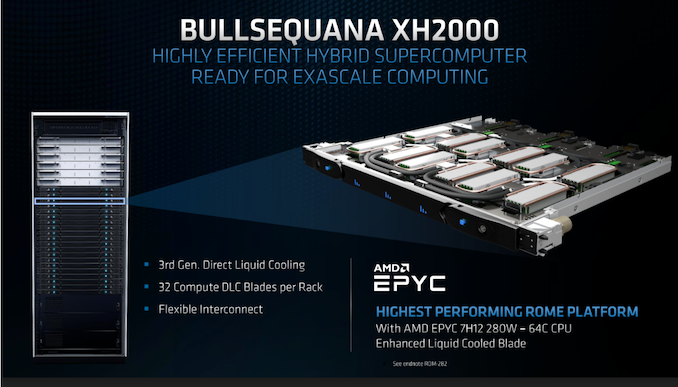AMD’s New 280W 64-Core Rome CPU: The EPYC 7H12
by Dr. Ian Cutress on September 18, 2019 9:15 AM EST
If there’s something that gets everyone excited, it is more performance. On the Enterprise side, AMD has made big strides with its latest EPYC processor stack, featuring up to 64 cores per socket with 128 PCIe 4.0 lanes and 8-channel memory, featuring a very high performance per dollar in the marketplace. In order to coincide with the launch of the processor line-up in Europe today, AMD is unveiling a new chip to act as the new Halo product: the EPYC 7H12.
The new processor features a higher base frequency and a higher boost frequency that the previous top-of-the-line processor, the EPYC 7742. The new EPYC 7H12 has a rated TDP of 280W, and as a result the chip is being marketed for server environments that offer liquid cooled solutions only. AMD is very specific about this, especially in the market for which this CPU is aimed at. One of AMD’s main partners, Atos, is set to offer an 1U solution featuring eight of these CPUs, all liquid cooled.
| AMD EPYC 7002 Processors (2P) | ||||||
| Cores Threads |
Frequency (GHz) | L3* | TDP | Price | ||
| Base | Max | |||||
| EPYC 7H12 | 64 / 128 | 2.60 | 3.30 | 256 MB | 280 W | ? |
| EPYC 7742 | 64 / 128 | 2.25 | 3.40 | 256 MB | 225 W | $6950 |
| EPYC 7702 | 64 / 128 | 2.00 | 3.35 | 256 MB | 200 W | $6450 |
| EPYC 7642 | 48 / 96 | 2.30 | 3.20 | 256 MB | 225 W | $4775 |
| EPYC 7552 | 48 / 96 | 2.20 | 3.30 | 192 MB | 200 W | $4025 |
For a base frequency, the EPYC 7H12 will be set at 2.6 GHz, and a turbo frequency of 3.3 GHz. Compared to the EPYC 7742, that’s +350 MHz on base and -100 MHz on turbo, for an increase in +55W TDP. The higher TDP means the 7H12 is expected to have an all-core turbo a lot higher than the 7742. The EPYC 7H12 is socket compatible with all other Rome processors.
With this new CPU, AMD is clearly going after the high-performance compute market. The chip still affords the same specifications as the rest of the stack, such as the PCIe lanes, the memory support, and security features, should any other market be interested, but AMD expects this CPU to be installed in large HPC datacenters. AMD published raw LINPACK metrics with a performance uplift of the 7H12 over the 7742 at around 11%.
We asked AMD if this is a chip designed for specific partners who can enable liquid cooling servers, or for any OEM that wants it. AMD responded stating the latter – this chip will have general availability, but given the target market, they are pushing it only for liquid cooled HPC systems. AMD states they have other processors better suited to certain other fields, such as finance.
We expect AMD’s OEM partners to be evaluating the 7H12 for their system offerings, with further announcements in due course.
Related Reading
- AMD Rome Second Generation EPYC Review: 2x 64-core Benchmarked
- The AMD 2nd Gen EPYC "Rome" Launch Live Blog
- Lenovo Launches ThinkSystem SR635 & SR655 Servers with AMD’s EPYC ‘Rome’ CPUs
- AMD Zen 2 Microarchitecture Analysis: Ryzen 3000 and EPYC Rome











54 Comments
View All Comments
deil - Wednesday, September 18, 2019 - link
can we get a image comment?that "offer an 1U solution featuring eight of these CPUs, all liquid cooled." deserves
the Jurassic park glasses gif....
~2500 W per blade, how to even cool that beast....
drexnx - Wednesday, September 18, 2019 - link
...with the aforementioned liquid?if you're talking about the liquid cooling, a water/water heat exchanger to a secondary common loop and that to an outside cooling tower/chiller.
google image search "ibm water cooling specification" and the first result will be a nice diagram
ACE76 - Thursday, September 19, 2019 - link
That makes more sense...kinda misleading the way they framed it in the article though.DanNeely - Wednesday, September 18, 2019 - link
drexnx gave a pointer to an existing implementation. The only thing I'd like to add is that this isn't anything new outside of starting to migrate toward commodity-ish systems. Enterprise scale watercooling has been used in some mainframe and super computer applications for something like half a century.FunBunny2 - Wednesday, September 18, 2019 - link
"used in some mainframe and super computer applications for something like half a century."to be more specific, liquid cooling came first, then air cooling. in the IBM case, it was the smaller, nearly mini-computer, systems that went air. pre-semiconductor mainframes had the chilled air blown over the tubes.
rahvin - Wednesday, September 18, 2019 - link
Not only not new, they've had this cooling infrastructure since the first mainframes in the 60's that were water cooled. I can remember a tour of a university in grade school where they showed us the now decommissioned mainframe from (IIRC) '62 that had water cooled CPU's hooked up to water chillers are the roof of the building.This is actually coming back into popularity because it can be quite a bit cheaper to run than the standard hot/cold isles in a traditional data center and it allows higher density because water can move way more heat than air.
peevee - Thursday, September 19, 2019 - link
Where do you see that "offer an 1U solution featuring eight of these CPUs"? Something not quite believable...A5 - Wednesday, September 18, 2019 - link
16k cores/32k threads per rack is really impressive.dcl88 - Wednesday, September 18, 2019 - link
That's at least 2M *just* in CPUs.ACE76 - Thursday, September 19, 2019 - link
They get big volume discounts